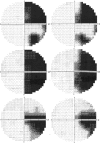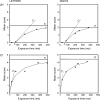Too little, too late: reduced visual span and speed characterize pure alexia
- PMID: 19366870
- PMCID: PMC2774391
- DOI: 10.1093/cercor/bhp059
Too little, too late: reduced visual span and speed characterize pure alexia
Abstract
Whether normal word reading includes a stage of visual processing selectively dedicated to word or letter recognition is highly debated. Characterizing pure alexia, a seemingly selective disorder of reading, has been central to this debate. Two main theories claim either that 1) Pure alexia is caused by damage to a reading specific brain region in the left fusiform gyrus or 2) Pure alexia results from a general visual impairment that may particularly affect simultaneous processing of multiple items. We tested these competing theories in 4 patients with pure alexia using sensitive psychophysical measures and mathematical modeling. Recognition of single letters and digits in the central visual field was impaired in all patients. Visual apprehension span was also reduced for both letters and digits in all patients. The only cortical region lesioned across all 4 patients was the left fusiform gyrus, indicating that this region subserves a function broader than letter or word identification. We suggest that a seemingly pure disorder of reading can arise due to a general reduction of visual speed and span, and explain why this has a disproportionate impact on word reading while recognition of other visual stimuli are less obviously affected.
Figures






Similar articles
-
About the role of visual field defects in pure alexia.Brain. 2009 Jul;132(Pt 7):1907-17. doi: 10.1093/brain/awp141. Epub 2009 Jun 4. Brain. 2009. PMID: 19498088
-
Do all visual deficits cause pure alexia? Dissociations between visual processing and reading suggest "no".Brain Cogn. 2018 Aug;125:69-77. doi: 10.1016/j.bandc.2018.05.008. Epub 2018 Jun 11. Brain Cogn. 2018. PMID: 29902728
-
From word superiority to word inferiority: visual processing of letters and words in pure alexia.Cogn Neuropsychol. 2014;31(5-6):413-36. doi: 10.1080/02643294.2014.906398. Epub 2014 May 7. Cogn Neuropsychol. 2014. PMID: 24801564
-
The word-length effect in reading: a review.Cogn Neuropsychol. 2014;31(5-6):378-412. doi: 10.1080/02643294.2014.895314. Epub 2014 Mar 26. Cogn Neuropsychol. 2014. PMID: 24665973 Review.
-
Patterns of peripheral paralexia: pure alexia and the forgotten visual dyslexia?Cortex. 2006 Aug;42(6):892-7. doi: 10.1016/s0010-9452(08)70433-7. Cortex. 2006. PMID: 17131595 Review.
Cited by
-
The putative visual word form area is functionally connected to the dorsal attention network.Cereb Cortex. 2012 Mar;22(3):537-49. doi: 10.1093/cercor/bhr100. Epub 2011 Jun 20. Cereb Cortex. 2012. PMID: 21690259 Free PMC article.
-
Dissociation of sensitivity to spatial frequency in word and face preferential areas of the fusiform gyrus.Cereb Cortex. 2011 Oct;21(10):2307-12. doi: 10.1093/cercor/bhr008. Epub 2011 Mar 2. Cereb Cortex. 2011. PMID: 21368088 Free PMC article. Clinical Trial.
-
Processing deficits for familiar and novel faces in patients with left posterior fusiform lesions.Cortex. 2015 Nov;72:79-96. doi: 10.1016/j.cortex.2015.02.003. Epub 2015 Feb 26. Cortex. 2015. PMID: 25837867 Free PMC article.
-
Category-selective deficits are the exception and not the rule: Evidence from a case-series of 64 patients with ventral occipito-temporal cortex damage.Cortex. 2021 May;138:266-281. doi: 10.1016/j.cortex.2021.01.021. Epub 2021 Feb 19. Cortex. 2021. PMID: 33770511 Free PMC article.
-
Reading without the left ventral occipito-temporal cortex.Neuropsychologia. 2012 Dec;50(14):3621-35. doi: 10.1016/j.neuropsychologia.2012.09.030. Epub 2012 Sep 25. Neuropsychologia. 2012. PMID: 23017598 Free PMC article.
References
-
- Allison T, McCarthy G, Nobre A, Puce A, Belger A. Human extrastriate visual cortex and the perception of faces, words, numbers, and colors. Cereb Cortex. 1994;4:544–554. - PubMed
-
- Anderson SW, Damasio AR, Damasio H. Troubled letters but not numbers. Domain specific cognitive impairments following focal damage in frontal cortex. Brain. 1990;113:749–766. - PubMed
-
- Barnett V, Lewis T. Outliers in statistical data. Chichester: John Wiley & Sons; 1994.
-
- Baylis GC, Driver J, Baylis LL, Rafal RD. Reading of letters and words in a patient with Balint's syndrome. Neuropsychologia. 1994;32:1273–1286. - PubMed
-
- Behrmann M, Nelson J, Sekuler EB. Visual complexity in letter-by-letter reading: “pure” alexia is not pure. Neuropsychologia. 1998;36:1115–1132. - PubMed
Publication types
MeSH terms
Grants and funding
LinkOut - more resources
Full Text Sources
Medical

